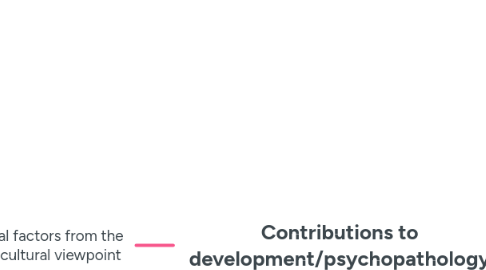
1. Causal factors from the sociocultural viewpoint
1.1. FOCUS: Human learning has it's basis in interacting with other people; parents, caregivers, peers and the culture at large are responsible for developing higher-order functions
1.1.1. Thus, development can differ between cultures, so the course and content of intellectual development is not universal
1.2. OF NOTE: Vygotsky
1.3. Key Concepts
1.3.1. Tools of Intellectual Adaptation
1.3.1.1. tools provided by a culture to allow children to use their abilities in a way that is adaptive and appropriate to their culture
1.3.1.1.1. eg. emphasis of memory strategies such as note-taking vs emphasis of reminders/rote memorisation
1.3.2. Zone of Proximal Development
1.3.2.1. Distance between the actual development of the learner by their own knowledge and independent problem solving skill, and the potential development of the learner that they are capable of achieving with help from a mentor or by collaboration with peers
1.3.2.1.1. As children stretch their skills and knowledge often by observing someone more advanced than they are, they are able to progressively extend the Zone
2. Causal factors from the biological viewpoint
2.1. Structural Brain Abnormalities
2.1.1. Degenerative brain diseases
2.1.2. Brain development
2.1.3. Other diseases
2.1.4. Trauma to the brain
2.1.4.1. eg Phineas Gage
2.1.5. Trauma to the nervous system
2.2. Neurochemical Imbalances
2.2.1. Drugs
2.2.2. Brain chemistry
2.2.2.1. Neurons
2.2.2.2. Neurotransmitters
2.3. Genetic factors
2.3.1. eg Evolutionary Psychology
2.3.2. eg Twin Studies
2.3.2.1. eg Jim Twins
3. Causal factors from the psychological viewpoint
3.1. Psychoanalytic perspective
3.1.1. Key concepts
3.1.1.1. The Unconscious/Latent Mind
3.1.1.1.1. All behaviours, both normal and abnormal are the results of conflict among the id, ego and superego
3.1.1.2. Defence Mechanisms
3.1.1.2.1. Anxiety/Guilt/Embarrassment/Shame
3.1.1.2.2. The ego employs defence mechanisms in response, to disguise/transform unacceptable unconscious wishes or impulses (see 1.3.2 in OneNote)
3.1.1.3. Neuroses
3.1.1.3.1. set of maladaptive symtpms caused by unconscious conflict and its associated anxiety
3.1.1.4. Psychoses
3.1.1.4.1. state involving loss of contact with reality,due to toxins, infections, or manifestations of intrapsychic conflict
3.1.1.4.2. occurs when usual defence mechanisms fail, and only way for ego to cope is to withdraw from reality
3.1.1.5. Normal and abnormal behaviours lie on a continuum, not belonging to distinct categories of health v illness.
3.1.1.6. symptoms disguise a more complex, underlying unconscious reality
3.1.1.6.1. two people with very similar symptoms may have developed those as result of very different underlying conflicts –
3.1.2. FOCUS: subjective experience of individual - explains human behaviour in terns of unobservable, unconscious processes
3.1.3. Stages of psychosexual development
3.1.3.1. id impulse gratification throughout childhood
3.1.3.1.1. Oral (0-2 years)
3.1.3.1.2. Anal (2-3 years)
3.1.3.1.3. Phallic (3-6 years)
3.1.3.1.4. Latent (6-12 years)
3.1.3.1.5. Genital (12+ years)
3.1.4. Contemporary psychodynamic perspectives
3.1.4.1. Object Relations
3.1.4.1.1. 'objects' are people to whom individuals are strongly attached
3.1.4.1.2. primary motive of behaviour is need for close relationship with others
3.1.4.2. Neo-Freudian
3.1.4.2.1. Horney, 1922/1967
3.1.4.2.2. Gilligan, 1982
3.2. Behavioural perspective
3.2.1. Key concepts
3.2.1.1. Normal and abnormal behaviour are both products of the same learning process
3.2.1.2. Adaptive and maladaptive behaviour is on a continuum, the difference between the two is only a matter of degree
3.2.1.3. Conditioning
3.2.1.3.1. Classical
3.2.1.3.2. Operant
3.2.1.3.3. Functional analysis of behaviour
3.2.1.3.4. Aversion therapy
3.2.1.3.5. Systematic desensitization
3.2.1.4. Token economies
3.2.1.4.1. receive tokens for desired behaviours which can be exchanged for privileges and rewards
3.2.2. FOCUS: human behaviour caused by stimuli that elicit, reinforce or punish a behaviour, and are observable and identifiable in the immediate environment - emphasises experimentation and objective measurement
3.2.3. OF NOTE: Pavlov; Watson; Thorndike; Skinner; Tolman; Bandura
3.2.4. Contemporary behavioural perspectives
3.2.4.1. Cognitive Behaviourism
3.2.4.1.1. Modelling
3.2.4.1.2. Reinforcement affects the rate of learning by creating thoughts predicting the likelihood of rewards and punishments
3.2.4.1.3. Learning cannot be explained without referring to internal, mental processes such as values, beliefs, thoughts or expectations
3.3. Cognitive perspective
3.3.1. FOCUS: individual's way of thinking and their subsequent impact on behaviour; dysfunctional cognitive processes cause emotional and behavioural disturbances
3.3.1.1. dysfunctional thoughts, behaviours and emotions of various psychological disorders are exaggerations of normal adaptive thoughts, behaviours and emotions
3.3.2. Key Concepts
3.3.2.1. Humans engage in active information processing
3.3.2.1.1. The way the information is processed influences the way they react to and interact with the environment
3.3.2.2. Selective Attention
3.3.2.2.1. Impossible to attend to all information in the environment at once; must select what to attend to, what to filter out
3.3.2.2.2. Adaptive process to enable processing of important information and disregard irrelevant distractions
3.3.2.2.3. Biases in selective attention are shown to be associated with psychological disorders
3.3.2.3. OF NOTE: Ellis; Beck
3.3.2.3.1. Albert Ellis
3.3.2.3.2. Aaron Beck
3.3.3. Therapist guides client to discover their own distorted patterns of thinking and replace with more rational thoughts consistent with reality
3.3.3.1. Cognitive Restructuring
3.3.3.1.1. change dysfunctional thinking patterns by generating and testing out alternative interpretations and predictions
3.3.3.2. Behavioural experiment
3.3.3.2.1. client participates in a planned activity in order to test the accuracy of their beliefs
